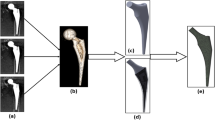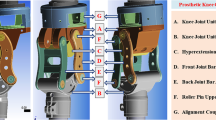Abstract
In total hip arthroplasty (THA), has been over time, an exponential growth of studies with Finite Element Method (FEM) computational simulation in order to obtain the prosthesis with a longer life duration, however just a few in COMSOL Multiphysics software. The main goal of this study was to perform stress and strain studies under different load conditions for the titanium and cobalt-chromium alloys in cementless prostheses. In software COMSOL Multiphysics, 3D models of a femur and a Lubinus SPII implant with two different alloys, were tested. Two COMSOL studies were carried out, one stationary and the other dynamic (time-dependent) for both material’s prostheses. In a stationary study for walking activity, the titanium alloy implant showed an equivalent von Mises stress maximum level of 0.9 × 108 Pa at the contact between the implant and the bone, having been found a similar value by other investigators ( Prasad, Karthika, et al. “Metallic biomaterials: current challenges and opportunities.“ Materials 10.8 (2017): 884.). In the Co-Cr alloy prosthesis, the equivalent von Mises stress for walking activity was like titanium alloy. The shear stress and normal stress of the two prostheses were compared. In the dynamic study for climbing stair activity the equivalent von Mises stress was greater 7.5 times than in walking activity for Co-Cr alloy implant. The maximum stress (stationary and dynamic) of the titanium alloy implant is slightly higher than the Co-Cr alloy implant, which indicates that Co-Cr prostheses react better when subjected to loads.
Access this chapter
Tax calculation will be finalised at checkout
Purchases are for personal use only
Similar content being viewed by others
References
A. Fontalis et al., Advances and innovations in total hip arthroplasty. SICOT-J 7 (2021)
M. Merola, S. Affatato, Materials for hip prostheses: a review of wear and loading considerations. Materials 12(3), 495 (2019)
D. Savio, A. Bagno, When the total hip replacement fails: A review on the stress-shielding effect. Processes 10(3), 612 (2022)
P. Forte, H. Neiva, D.A. Marinho, Sports biomechanics: monitoring health and performance. J Men’s Health 1 (2021)
S. Chatterjee, Finite Element Analysis in Biomechanics. Advances in Computational Approaches in Biomechanics. IGI Global, pp. 16–47 (2022)
J. Anguiano-Sanchez, et al., Influence of PEEK coating on hip implant stress shielding: a finite element analysis. Computational and mathematical methods in medicine (2016)
B. Innocenti et al., The use of computational models in orthopedic biomechanical research. Human Orthopaedic Biomechanics. Academic Press, pp. 681–712 (2022)
J. Jamari, et al., Adopted walking condition for computational simulation approach on bearing of hip joint prosthesis: review over the past 30 years. Heliyon e12050 (2022)
M.S.M. Suri, et al.,Influence of dimple depth on lubricant thickness in elastohydrodynamic lubrication for metallic hip implants using fluid structure interaction (FSI) approach. Malaysian J. Med. Heal. Sci. 16, 28–34 (2020)
S. Joseph, Clinical and functional outcome of total hip replacement (Rajiv Gandhi University of Health Sciences (India), Diss, 2010)
S. Renner, Determination of muscle forces acting on the femur and stress analysis. no. November, pp. 1–97 (2007)
R. Glenister, S. Sharma, Anatomy, bony pelvis and lower limb, hip. StatPearls [Internet]. StatPearls Publishing (2021)
K.N. Chethan, et al., Comparative study of femur bone having different boundary conditions and bone structure using finite element method. Open Biomed. Eng. J. 12.1 (2018)
P. Damm, et al., ESB Clinical biomechanics award 2018: muscle atrophy-related increased joint loading after total hip arthroplasty and their postoperative change from 3 to 50 months. Clin. Biomech. 65, 105-109 (2019)
D.P. Byrne, K.J. Mulhall, J.F. Baker, Anatomy & biomechanics of the hip. Open Sports Med. J. 4.1 (2010)
K.N. Chethan et al., Static structural analysis of different stem designs used in total hip arthroplasty using finite element method. Heliyon 5(6), e01767 (2019)
F. Van Praet, M. Mulier, To cement or not to cement acetabular cups in total hip arthroplasty: a systematic review and re-evaluation. SICOT-J 5 (2019)
A. Vieira, A.T. Marques, J.A. Simões, Caracterização à Fadiga de Próteses de Anca Compósitas. Revista da Associação Portuguesa de Análise Experimental de Tensões ISSN 1646, 7078 (2008)
C.Y. Hu, T.-R. Yoon, Recent updates for biomaterials used in total hip arthroplasty. Biomater. Res. 22.1, 1–12 (2018)
K. Magalhães, Avaliação biomecânica do desempenho de prótese femoral com rigidez variável. Diss. Instituto Politecnico de Braganca (Portugal) (2014)
Guedes, José Américo da Silva, Estudo numérico e experimental da biomecânica do fémur intacto e com prótese de anca inserida: Biomecânica da anca (2000)
J. Maggs, M. Wilson, The relative merits of cemented and uncemented prostheses in total hip arthroplasty. Indian J. Orthopaed. 51, 377–385 (2017)
M. Varacallo, et al., Joint perception and patient perceived satisfaction after total hip and knee arthroplasty in the American population. J. Orthop. 15.2, 495–499 (2018)
Y.E. Delikanli, M.C. Kayacan, Design, manufacture, and fatigue analysis of lightweight hip implants. J. Appl. Biomater. Funct. Mater. 17(2), 2280800019836830 (2019)
M.R. Feldesman, J. Geoffrey Kleckner, J.K. Lundy, Femur/stature ratio and estimates of stature in mid‐and late‐Pleistocene fossil hominids. Am. J. Phys. Anthropol. 83.3, 359–372 (1990)
C. Mulenga, A cross-section study to determine human height using femur length in Zambian population. Acta Sci. Microb. 2(11), 57–61 (2019)
M. Wod, Height estimation from Skeletal remains. Student thesis in Biological Anthropology. Institute of Biology, University of Southern Denmark (2008)
N. Özkaya, et al., Applications of statics to biomechanics. Fundamentals of Biomechanics: Equilibrium, Motion, and Deformation, 101–139 (2017)
J. Skubich, S. Piszczatowski, Model of loadings acting on the femoral bone during gait. J. Biomech. 87, 54–63 (2019)
Ramos, António Manuel de Amaral Monteiro. Estudo numérico e experimental de uma nova componente femoral da prótese de anca cimentada. Diss. Universidade de Aveiro (Portugal) (2006)
A. Martins, Análise da Marcha na Artroplastia da Anca (Faculdade de Desporto da Universidade do Porto, Diss, 2007)
R. Phellan ., Real‐time biomechanics using the finite element method and machine learning: review and perspective. Med. Phy. 48.1, 7–18 (2021)
J.C. Fialho et al., Computational hip joint simulator for wear and heat generation. J. Biomech. 40.11, 2358–2366 (2007)
J.E. Gubaua, G. Wessling Oening Dicati, J. Tomás Pereira, Influence of material stiffness of total hip prosthesis in isotropic bone-remodeling process analysis. Conf. XXXVIII Iberian-Latin Am. Congr. Comput. Methods Eng. (2017)
Y. Peng, et al., Computational modeling of polyethylene wear in total hip arthroplasty using patient-specific kinematics-coupled finite element analysis. Tribol. Intern. 129, 162–166 (2019)
M.I. Ammarullah, et al., Wear analysis of acetabular cup on metal-on-metal total hip arthroplasty with dimple addition using finite element method. AIP Conf. Proc. 2391(1), AIP Publishing LLC (2022)
H. Basri et al.,The analysis of dimple geometry on artificial hip joint to the performance of lubrication. J. Phy. Conf. Series. 1198(4), IOP Publishing (2019)
H. Basri et al., The analysis of the dimple arrangement of the artificial hip joint to the performance of lubrication. IOP Conf. Series: Mater. Sci. Eng. 620(1), IOP Publishing (2019)
I. Campioni, et al., Hip prostheses computational modeling: FEM simulations integrated with fatigue mechanical tests. Biomed. Imaging Comput. Model. Biomech., 81–108 (2013)
X. Song, et al., Construction of breast cancer photoacoustic imaging model based on COMSOL. 4th Optics Young Scientist Summit (OYSS 2020) 11781. SPIE (2021)
Z. KHOMSI, et al.,Contribution for the early detection of breast cancer by a superficial thermography solution. 2020 International Conference on Electrical and Information Technologies (ICEIT). IEEE (2020)
D. Wang et al., Nano-scale physical properties characteristic to metastatic intestinal cancer cells identified by high-speed scanning ion conductance microscope. Biomaterials 280, 121256 (2022)
M.R. Gorji, et al., Analysis of the effect of liquid viscosity on the aerosol distribution during Pressurized Intraperitoneal Aerosol Chemotherapy (PIPAC) using computational modeling. Eur. J. Surg. Oncol. 48.2, e159 (2022)
M.I. Almomani, Y.F. Makableh, M. Al-Fandi, Design and numerical simulation of a nanostructured ultraviolet shield for radiation protection applications using COMSOL. Mater. Today Commun. 33, 104148 (2022)
R.T. Shuvo, A.S.M. Shamsul Arefin, Simulation based non-invasive detection of skin cancer (Basal Cell Carcinoma) using millimeter-wave reflectometry. 2020 IEEE Region 10 Symposium (TENSYMP). IEEE (2020)
M. Radmilović-Radjenović, et al., Finite element analysis of the microwave ablation method for enhanced lung cancer treatment. Cancers 13.14, 3500 (2021)
T. Akano, Numerical study of prosthetic knee replacement using finite element analysis. J. Biomimet. Biomater. Biomed. Eng. 44, Trans Tech Publications Ltd. (2020)
R. Ji, et al., Numerical and experimental investigation on the abrasive flow machining of artificial knee joint surface. Crystals 13.3, 430 (2023)
E. Dosmar, et al., Compartmental and COMSOL multiphysics 3D modelling of drug diffusion to the vitreous following the administration of a sustained-release drug delivery system. Pharmaceutics 13.11, 1862 (2021)
R.V. Suganthan, et al., Finite element analysis of the human eye for a range of intraocular pressure. Adv. Control Instrum. Syst., 173–181 (2020)
H. Shatnawi, Computational fluid flow model for the development of an arterial bypass graft. CFD Lett. 14(10), 99–111 (2022)
M.S.A. Jamali, Z. Ismail, N. Saidina Amin, Effect of different types of stenosis on generalized power law model of blood flow in a bifurcated artery. J. Adv. Res. Fluid Mech. Thermal Sci. 87.3, 172–183 (2021)
N. Khadka, M. Yadav, A. Ghimire, Novel stemless hip prosthesis design and finite element analysis to validate stemless prosthesis for reduction of aseptic loosening in total hip arthroplasty (2020)
W. Prins et al., Excellent results with the cemented Lubinus SP II 130-mm femoral stem at 10 years of follow-up: 932 hips followed for 5–15 years. Acta Orthopaedica 85.3, 276–279 (2014)
M.O. Heller et al., Determination of muscle loading at the hip joint for use in pre-clinical testing. J. Biomech. 38(5), 1155–1163 (2005)
N. Verdonschot, Preclinical testing of cemented THR implants: pre-normative research for European standard. Proceedings of the 14th conference of European Society of Biomechanics (2004)
J. WlodarsKi, Mechanical conditions of endurance of the joint: bone cement implant. Proceedings of the 13th conference of European Society of Biomechanics, 294–295 (2002)
K. Prasad, et al., Metallic biomaterials: current challenges and opportunities. Materials 10.8, 884 (2017)
C. Luo, et al., Femoral stress changes after total hip arthroplasty with the ribbed prosthesis: a finite element analysis. BioMed Res. Intern. (2020)
C. Truesdell, et al., The non-linear field theories of mechanics. Springer Berlin Heidelberg (2004)
Author information
Authors and Affiliations
Corresponding author
Editor information
Editors and Affiliations
Rights and permissions
Copyright information
© 2023 The Author(s), under exclusive license to Springer Nature Switzerland AG
About this chapter
Cite this chapter
Gueiral, N., Nogueira, E. (2023). Total Hip Arthroplasty Modelling and Load Simulation, in COMSOL Multiphysics. In: Daimi, K., Alsadoon, A., Seabra Dos Reis, S. (eds) Current and Future Trends in Health and Medical Informatics. Studies in Computational Intelligence, vol 1112. Springer, Cham. https://doi.org/10.1007/978-3-031-42112-9_15
Download citation
DOI: https://doi.org/10.1007/978-3-031-42112-9_15
Published:
Publisher Name: Springer, Cham
Print ISBN: 978-3-031-42111-2
Online ISBN: 978-3-031-42112-9
eBook Packages: Intelligent Technologies and RoboticsIntelligent Technologies and Robotics (R0)




